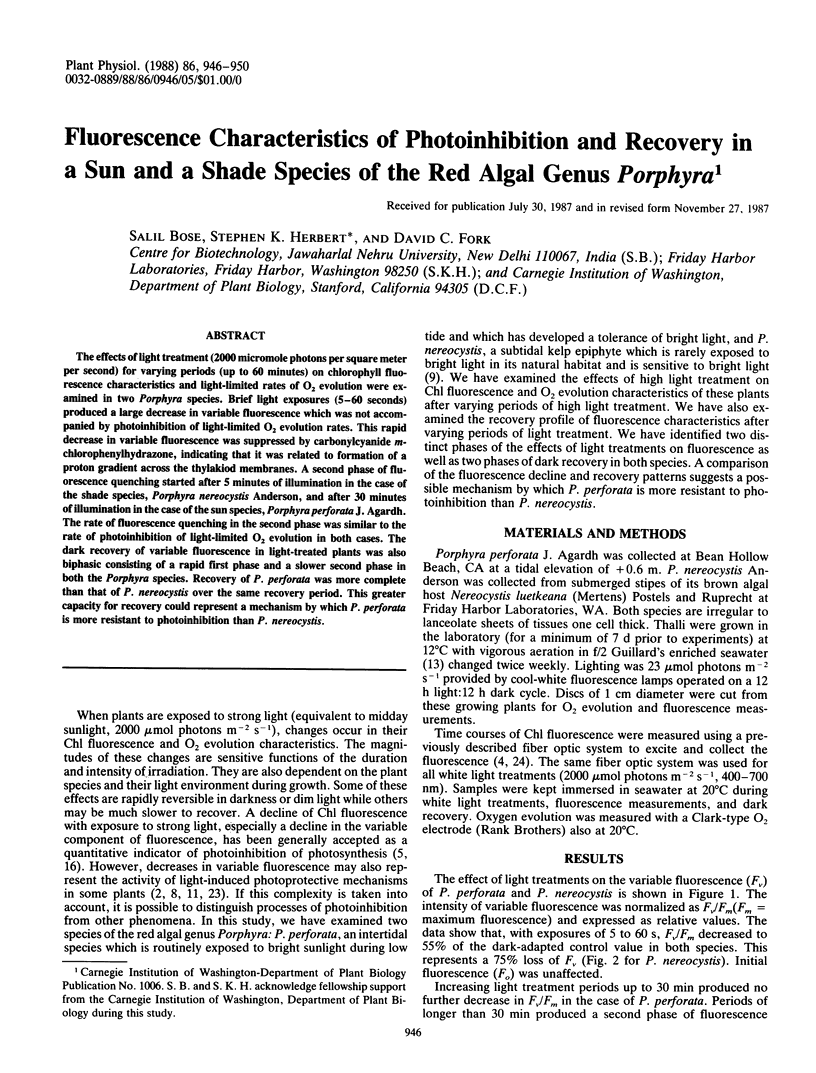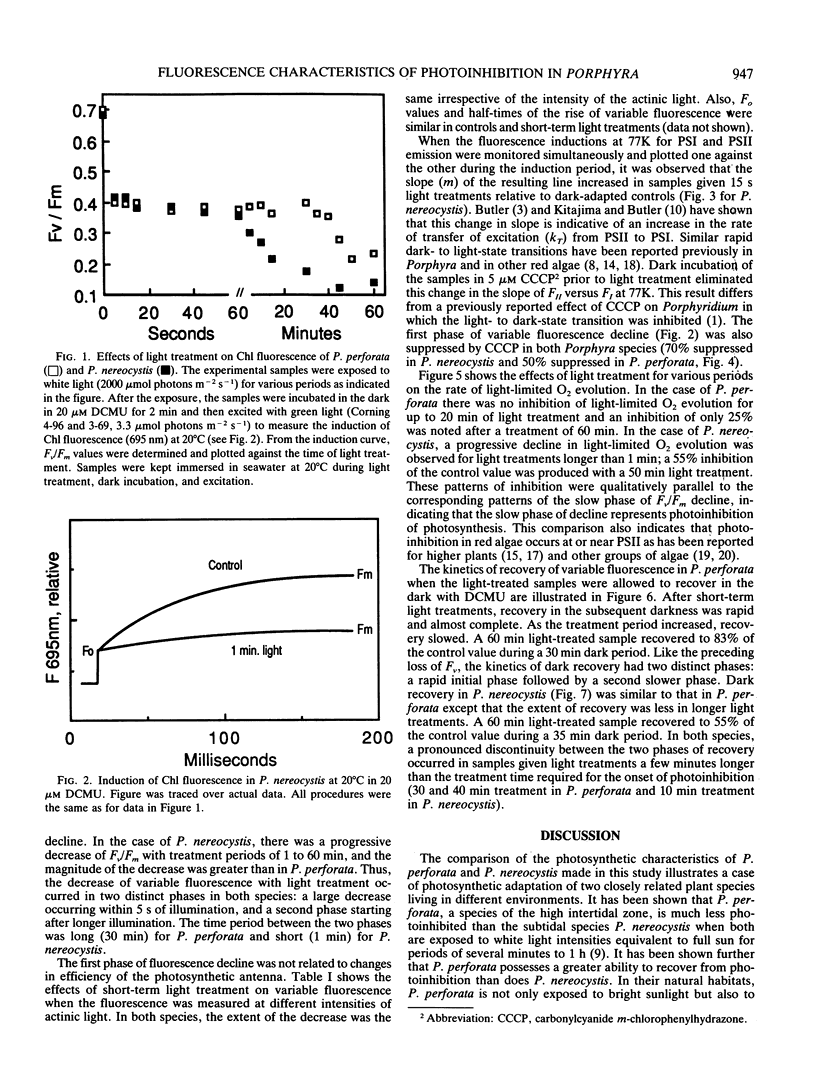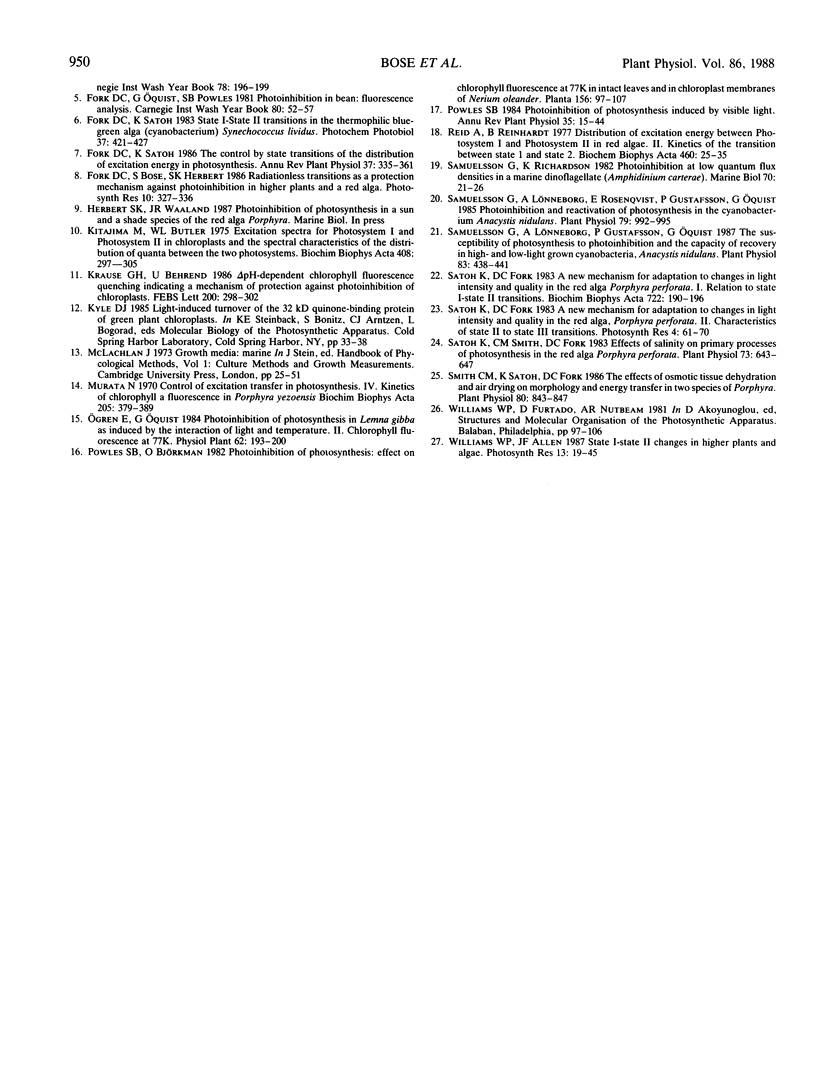Abstract
The effects of light treatment (2000 micromole photons per square meter per second) for varying periods (up to 60 minutes) on chlorophyll fluorescence characteristics and light-limited rates of O2 evolution were examined in two Porphyra species. Brief light exposures (5-60 seconds) produced a large decrease in variable fluorescence which was not accompained by photoinhibition of light-limited O2 evolution rates. This rapid decrease in variable fluorescence was suppressed by carbonylcyanide m-chlorophenylhydrazone, indicating that it was related to formation of a proton gradient across the thylakiod membranes. A second phase of fluorescence quenching started after 5 minutes of illumination in the case of the shade species, Porphyra nereocystis Anderson, and after 30 minutes of illumination in the case of the sun species, Porphyra perforata J. Agardh. The rate of fluorescence quenching in the second phase was similar to the rate of photoinhibition of light-limited O2 evolution in both cases. The dark recovery of variable fluorescence in light-treated plants was also biphasic consisting of a rapid first phase and a slower second phase in both the Porphyra species. Recovery of P. perforata was more complete than that of P. nereocystis over the same recovery period. This greater capacity for recovery could represent a mechanism by which P. perforata is more resistant to photoinhibition than P. nereocystis.
Full text
PDF




Selected References
These references are in PubMed. This may not be the complete list of references from this article.
- Kitajima M., Butler W. L. Excitation spectra for photosystem I and photosystem II in chloroplasts and the spectral characteristics of the distributions of quanta between the two photosystems. Biochim Biophys Acta. 1975 Dec 11;408(3):297–305. doi: 10.1016/0005-2728(75)90131-0. [DOI] [PubMed] [Google Scholar]
- Murata N. Control of excitation transfer in photosynthesis. IV. Kinetics of chlorophyll a fluorescence in Porphyra yezoensis. Biochim Biophys Acta. 1970 Jun 30;205(3):379–389. doi: 10.1016/0005-2728(70)90104-0. [DOI] [PubMed] [Google Scholar]
- Ried A., Reinhardt B. Distribution of excitation energy between photosystem I and photosystem II in red algae. II. Kinetics of the transition between state 1 and state 2. Biochim Biophys Acta. 1977 Apr 11;460(1):25–35. doi: 10.1016/0005-2728(77)90148-7. [DOI] [PubMed] [Google Scholar]
- Samuelsson G., Lönneborg A., Gustafsson P., Oquist G. The Susceptibility of Photosynthesis to Photoinhibition and the Capacity of Recovery in High and Low Light Grown Cyanobacteria, Anacystis nidulans. Plant Physiol. 1987 Feb;83(2):438–441. doi: 10.1104/pp.83.2.438. [DOI] [PMC free article] [PubMed] [Google Scholar]
- Samuelsson G., Lönneborg A., Rosenqvist E., Gustafsson P., Oquist G. Photoinhibition and Reactivation of Photosynthesis in the Cyanobacterium Anacystis nidulans. Plant Physiol. 1985 Dec;79(4):992–995. doi: 10.1104/pp.79.4.992. [DOI] [PMC free article] [PubMed] [Google Scholar]
- Satoh K., Smith C. M., Fork D. C. Effects of Salinity on Primary Processes of Photosynthesis in the Red Alga Porphyra perforata. Plant Physiol. 1983 Nov;73(3):643–647. doi: 10.1104/pp.73.3.643. [DOI] [PMC free article] [PubMed] [Google Scholar]
- Smith C. M., Satoh K., Fork D. C. The effects of osmotic tissue dehydration and air drying on morphology and energy transfer in two species of porphyra. Plant Physiol. 1986 Apr;80(4):843–847. doi: 10.1104/pp.80.4.843. [DOI] [PMC free article] [PubMed] [Google Scholar]


